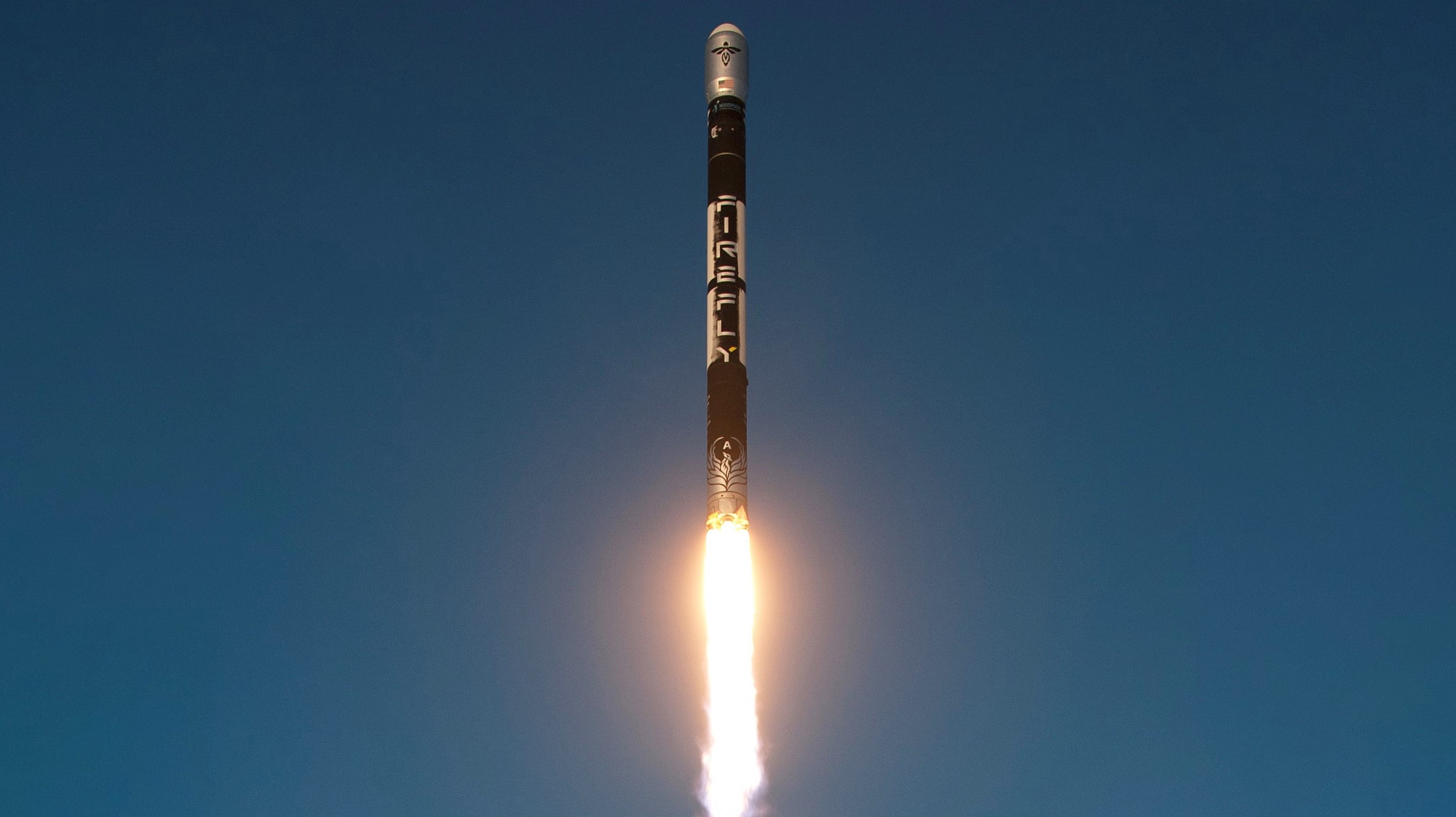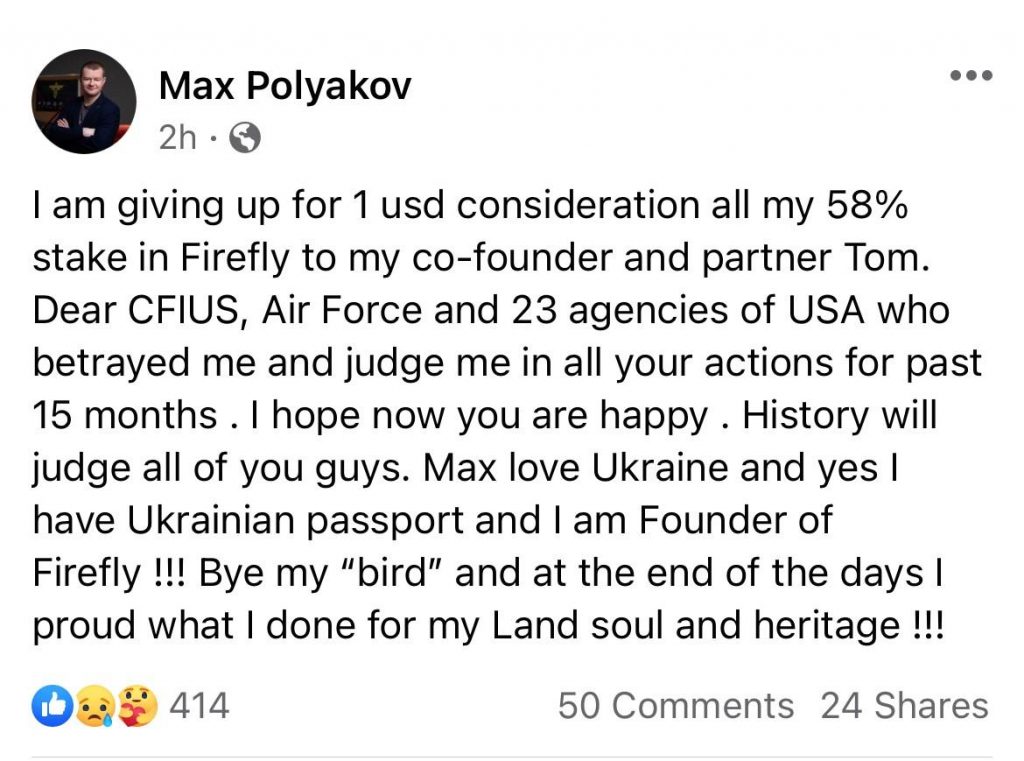

News
Firefly nears second orbital launch attempt as US forces Ukrainian founder to divest
While the rocket startup he is responsible for resurrecting is preparing for a second orbital launch attempt, a Ukrainian multimillionaire – an entrepreneur, businessman, and the founder of Firefly Aerospace – has once again been forced to take extreme actions by the US government.
Resurrected in 2017 after going bankrupt and ceasing operations the year prior, Firefly is a private launch provider based out of Austin, Texas and founded by Maxim Polyakov and former CEO Tom Markusic. Polyakov has supported the company since its second inception, privately funding the startup with over $200 million earned through success in Ukrainian tech industries. With those contributions, Polyakov was able to singlehandedly resurrect the startup from bankruptcy and continue the development of an even more ambitious Alpha launch vehicle.
For the last two years, though, Polyakov has been under scrutiny from US government officials, who’ve objected to Polyakov – a Ukrainian and UK citizen – having control over the company, with fears that the launch technology developed by the company could make its way back to Ukraine and poses a national security threat.
The update that's rolling out to the fleet makes full use of the front and rear steering travel to minimize turning circle. In this case a reduction of 1.6 feet just over the air— Wes (@wmorrill3) April 16, 2024
In late 2020, Polyakov quietly stepped down as chairman and withdrew from Firefly’s day-to-day operations in the hopes of killing the controversy and giving the startup a better chance at being awarded government contracts. Firefly’s board of directors includes many former U.S government officials, including Deborah Lee James, former secretary of the Air Force, and Robert Cardillo, former director of the National Geospatial Intelligence Agency.
However, officials were not satisfied with Polyakov simply stepping down from operations, indicating they want him to have less ownership in the company as well. In November 2021, just two months after Firefly’s inaugural flight test, Polyakov received a letter from the Committee on Foreign Investment in the U.S (CFIUS). This letter expressed these ongoing concerns and asked that he, along with his investment company, Noosphere Venture Partners, sell their stock in Firefly; which amounted to over 50% stake in the company. Because of this request, Firefly halted their operations at Vandenberg Air-force Base.
Before halting launch operations, Firefly claimed to be on track for another Alpha launch as early as January 2022. Firefly’s first launch on September 2nd, 2021 ended in failure around two minutes after liftoff due to a premature engine shutdown. Jason Mello, president of Firefly Space Transportation Services, stated in an interview that fixing the problem responsible for the failure was “fairly easy and straightforward.”
On February 16th, 2022 Polyakov revealed that the United States government had once again gone on the offensive, this time forcing him to fully and permanently cede any involvement in his company. He posted the following statement on Facebook:

Polyakov revealed that he chose to sell his 58% stake in the company to co-founder and CEO Tom Markusic for $1 USD – a selfless act given that selling his stake for nothing all but guarantees he will never recoup a cent of the several hundred million dollars he invested in Firefly.
Previously, Polyakov expressed how excited he was to turn Firefly into a massive aerospace company that both the United States and Ukraine could be proud of and benefit from. “During the Soviet era, Ukraine produced some of the world’s best rocket and engine technology, but much of those inventions have languished in recent years due to lack of investment. The hope was that Firefly could pair its best engineers from the U.S. and Ukraine together to make a fleet of large rockets capable of taking many satellites into orbit and, later on, missions to the moon. Polyakov wanted the U.S. to gain access to Ukrainian expertise, while also finding a way to boost the prospects of Ukrainian aerospace engineers, he has said.” (Bloomberg)
It is speculated that the US government’s sudden and extreme requests came because of concerns over the rising tensions caused by Russia’s increasingly unstable posturing and recurring threats of invasion. Even though Ukraine is friendly with the United States, concerns of conflict with Russia may have increased worries about what might happen to technology developed inside of the country. Ukraine, a sovereign nation, has been forced to increase security along its borders as fear of a Russian invasion grows.
Despite the recent legal and organizational setbacks and drama caused by the US government, Firefly has been doing extremely well from a technical standpoint. The company recently shared a video of the successful static fire testing of both stages of the second Alpha rocket, indicating that it could be ready for flight in the very near future. Even though Polyakov was forced to abandon his aerospace startup, it’s never been more clear that his investment not only saved Firefly but raised the company closer to success than it’s ever been before.
News
Tesla begins Robotaxi certification push in Arizona: report
Tesla seems serious about expanding its Robotaxi service to several states in the coming months.

Tesla has initiated discussions with Arizona transportation regulators to certify its driverless Robotaxi service in the state, as per a recent report from Bloomberg News. The move follows Tesla’s launch of its Robotaxi pilot program in Austin, Texas, as well as CEO Elon Musk’s recent comments about the service’s expansion in the Bay Area.
The Arizona Department of Transportation confirmed to Bloomberg that Tesla has reached out to begin the certification process for autonomous ride-sharing operations in the state. While details remain limited, the outreach suggests that Tesla is serious about expanding its driverless Robotaxi service to several territories in the coming months.
The Arizona development comes as Tesla prepares to expand its service area in Austin this weekend, as per CEO Elon Musk in a post on X. Musk also stated that Tesla is targeting the San Francisco Bay Area as its next major market, with a potential launch “in a month or two,” pending regulatory approvals.
Tesla first launched its autonomous ride-hailing program on June 22 in Austin with a small fleet of Model Y vehicles, accompanied by a Tesla employee in the passenger seat to monitor safety. While still classified as a test, Musk has said the program will expand to about 1,000 vehicles in the coming months. Tesla will later upgrade its Robotaxi fleet with the Cyercab, a two-seater that is designed without a steering wheel.
Sightings of Cybercab castings around the Giga Texas complex suggests that Tesla may be ramping the initial trial production of the self-driving two-seater. Tesla, for its part, has noted in the past that volume production of the Cybercab is expected to start sometime next year.
In California, Tesla has already applied for a transportation charter-party carrier permit from the state’s Public Utilities Commission. The company is reportedly taking a phased approach to operating in California, with the Robotaxi service starting with pre-arranged rides for employees in vehicles with safety drivers.
News
Tesla sets November 6 date for 2025 Annual Shareholder Meeting
The automaker announced the date on Thursday in a Form 8-K.

Tesla has scheduled its 2025 annual shareholder meeting for November 6, addressing investor concerns that the company was nearing a legal deadline to hold the event.
The automaker announced the date on Thursday in a Form 8-K submitted to the United States Securities and Exchange Commission (SEC). The company also listed a new proposal submission deadline of July 31 for items to be included in the proxy statement.
Tesla’s announcement followed calls from a group of 27 shareholders, including the leaders of large public pension funds, which urged Tesla’s board to formally set the meeting date, as noted in a report from The Wall Street Journal.
The group noted that under Texas law, where Tesla is now incorporated, companies must hold annual meetings within 13 months of the last one if requested by shareholders. Tesla’s previous annual shareholder meeting was held on June 13, 2024, which placed the July 13 deadline in focus.
Tesla originally stated in its 2024 annual report that it would file its proxy statement by the end of April. However, an amended filing on April 30 indicated that the Board of Directors had not yet finalized a meeting date, at least at the time.
The April filing also confirmed that Tesla’s board had formed a special committee to evaluate certain matters related to CEO Elon Musk’s compensation plan. Musk’s CEO performance award remains at the center of a lengthy legal dispute in Delaware, Tesla’s former state of incorporation.
Due to the aftermath of Musk’s legal dispute about his compensation plan in Delaware, he has not been paid for his work at Tesla for several years. Musk, for his part, has noted that he is more concerned about his voting stake in Tesla than his actual salary.
At last year’s annual meeting, TSLA shareholders voted to reapprove Elon Musk’s compensation plan and ratified Tesla’s decision to relocate its legal domicile from Delaware to Texas.
Elon Musk
Grok coming to Tesla vehicles next week “at the latest:” Elon Musk
Grok’s rollout to Tesla vehicles is expected to begin next week at the latest.

Elon Musk announced on Thursday that Grok, the large language model developed by his startup xAI, will soon be available in Tesla vehicles. Grok’s rollout to Tesla vehicles is expected to begin next week at the latest, further deepening the ties between the two Elon Musk-led companies.
Tesla–xAI synergy
Musk confirmed the news on X shortly after livestreaming the release of Grok 4, xAI’s latest large language model. “Grok is coming to Tesla vehicles very soon. Next week at the latest,” Musk wrote in a post on social media platform X.
During the livestream, Musk and several members of the xAI team highlighted several upgrades to Grok 4’s voice capabilities and performance metrics, positioning the LLM as competitive with top-tier models from OpenAI and Google.
The in-vehicle integration of Grok marks a new chapter in Tesla’s AI development. While Tesla has long relied on in-house systems for autonomous driving and energy optimization, Grok’s integration would introduce conversational AI directly into its vehicles’ user experience. This integration could potentially improve customer interaction inside Tesla vehicles.
xAI and Tesla’s collaborative footprint
Grok’s upcoming rollout to Tesla vehicles adds to a growing business relationship between Tesla and xAI. Earlier this year, Tesla disclosed that it generated $198.3 million in revenue from commercial, consulting, and support agreements with xAI, as noted in a report from Bloomberg News. A large portion of that amount, however, came from the sale of Megapack energy storage systems to the artificial intelligence startup.
In July 2023, Musk polled X users about whether Tesla should invest $5 billion in xAI. While no formal investment has been made so far, 68% of poll participants voted yes, and Musk has since stated that the idea would be discussed with Tesla’s board.
-

 Elon Musk1 week ago
Elon Musk1 week agoTesla investors will be shocked by Jim Cramer’s latest assessment
-

 Elon Musk3 days ago
Elon Musk3 days agoElon Musk confirms Grok 4 launch on July 9 with livestream event
-

 Elon Musk14 hours ago
Elon Musk14 hours agoxAI launches Grok 4 with new $300/month SuperGrok Heavy subscription
-

 News7 days ago
News7 days agoTesla Model 3 ranks as the safest new car in Europe for 2025, per Euro NCAP tests
-

 Elon Musk2 weeks ago
Elon Musk2 weeks agoA Tesla just delivered itself to a customer autonomously, Elon Musk confirms
-

 Elon Musk1 week ago
Elon Musk1 week agoxAI’s Memphis data center receives air permit despite community criticism
-

 Elon Musk2 weeks ago
Elon Musk2 weeks agoTesla’s Omead Afshar, known as Elon Musk’s right-hand man, leaves company: reports
-

 News2 weeks ago
News2 weeks agoXiaomi CEO congratulates Tesla on first FSD delivery: “We have to continue learning!”

















